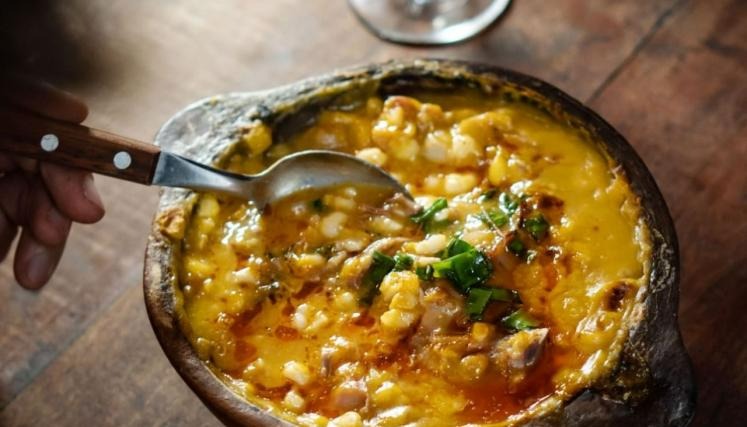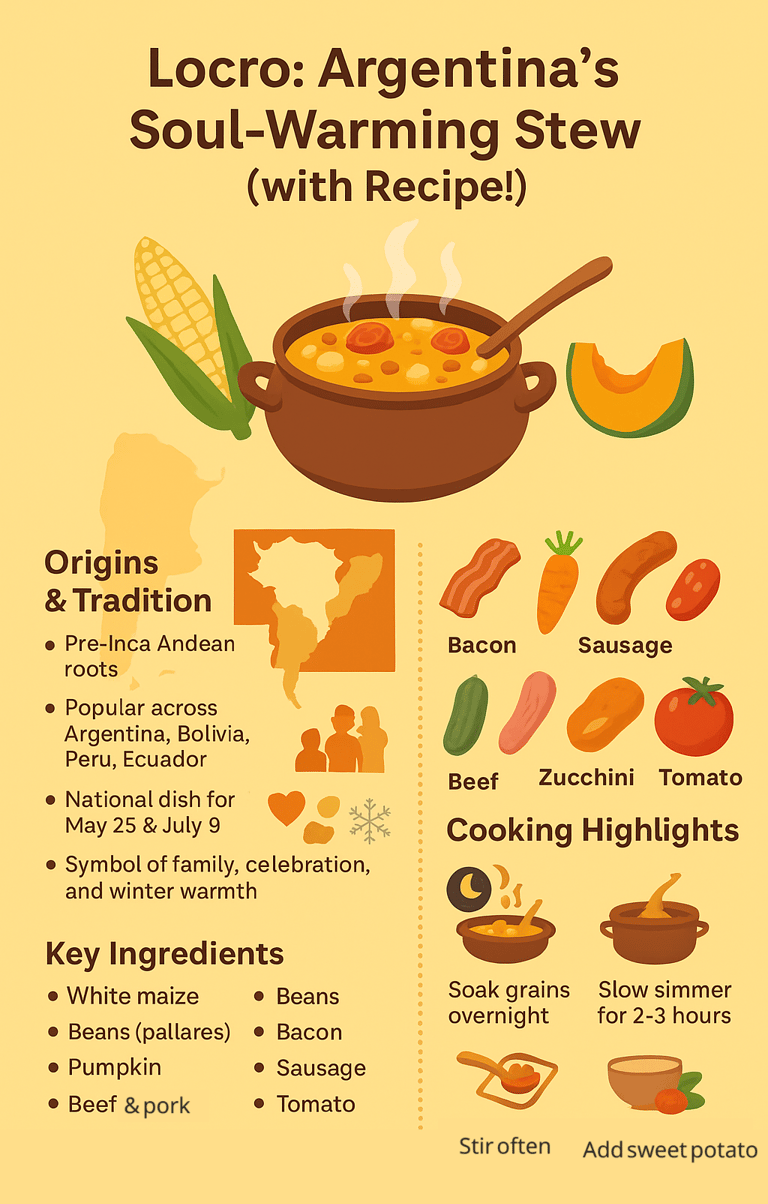Locro: Argentina’s Winter Stew (with Recipe!)
Discover locro, one of Argentina’s signature dishes that few visitors know. This hearty stew captures the country’s Andean roots and offers a taste of Argentina beyond the famous asado. Recipe included in English!
CULINARYCUISINETRADITIONS
Gabriela Arellano
10/22/20253 min read


Few dishes in South America carry as much history in a single spoonful as locro. More than a hearty stew, it is a vessel of memory—its origins stretching back to pre-Inca times, when maize, squash, and potatoes were the sacred gifts of the earth. From highland communities in Ecuador, Peru, Bolivia, and Colombia to the southern valleys of Argentina and Paraguay, locro has traveled and transformed, adapting to climates, ingredients, and cultures.
In Argentina, locro has transcended its Andean roots to become a true national dish, especially tied to the spirit of independence. On May 25th, the anniversary of the 1810 May Revolution, and on July 9th, the day of Argentina’s formal declaration of independence in 1816, pots of locro simmer in plazas, schools, and homes. To share a steaming bowl is to honor a people’s struggle for freedom while seeking comfort in the flavors of their land.
A Meeting of Worlds in a Clay Pot
At its core, locro is slow food in the truest sense: maize kernels, beans, squash, and other starchy vegetables bubbling away for hours until they meld into a dense, almost creamy consistency. This Andean foundation, however, absorbed European influences after the Spanish conquest. Pork, beef, sausages, and seasonings joined the pot, giving birth to the robust Argentine versions known today.
Each region contributes its voice to the stew:
🟢 Neuquén: peas sometimes replace maize.
🌿 Northeast: cassava forms the base.
🌶️ Northwest: richer, spicier broths, occasionally laced with fiery ají cumbarí.
🍲 Locro pulsudo: a dense and lavish stew brimming with meats and spices.
🥣 Huaschalocro: a humbler “poor man’s” version with few ingredients, closer to a porridge.
👉 Regardless of style, the secret lies in patience: a long, slow simmer that allows grains to release their starch and bind everything together.
And then, the finishing touch: a spoonful of quiquirimichi—a bright, spicy sauce of oil, paprika, chili, and spring onions—drizzled over each serving, adding heat and perfume to the bowl.
A Dish for Winter, a Ritual for the Nation
Locro is more than sustenance. It is a communal meal designed for cold days, to warm both body and spirit. Its dense calories and deep flavors make it the quintessential winter dish, often paired with a glass of robust Argentine Malbec. In warmer weather, a crisp Torrontés white wine provides a refreshing counterpoint.
Beyond the table, locro is a ritual. To prepare it is to gather: family in kitchens, neighbors in community centers, citizens in plazas. Weddings may feature small clay bowls of locro as a gesture of abundance and togetherness. In schools, it stands alongside hot chocolate, pastries, and mate cocido as part of Argentina’s patriotic calendar, feeding not just the body but also a shared identity.
📝 Locro Recipe (Serves 10–12)
Ingredients
🌽 500 g white maize (soaked overnight)
🫘 300 g beans (e.g., pallares, soaked overnight)
🎃 1 kg pumpkin or squash (zapallo plomo if available)
🍠 1 kg sweet potatoes
🥕 350 g carrots
🧅 200 g onions
🌶️ 200 g red bell pepper
🥬 100 g cabbage
🍅 200 g tomatoes
🥒 200 g zucchini
🥓 350 g bacon
🌭 2 spicy sausages (chorizo colorado)
🐄 400 g beef (stew cuts)
🐖 500 g pork ribs or pork cuts
🍖 1 pig’s foot
🐄 800 g tripe (optional, for the traditional version)
🧂 Salt and spices to taste


Preparation
Soak maize and beans separately overnight.
Boil the tripe (if using) for 1 hour, then cut into strips.
Chop all vegetables into cubes.
Cut meats into medium pieces; slice sausages and bacon.
In a very large pot, cook maize with its soaking water, adding bacon and sausages.
In another pot, cook the beans until half-done, then set aside.
Add meats and chopped vegetables to the maize pot.
When the beans are semi-cooked, add them (with some of their liquid) to the main pot.
Simmer very gently for 2½–3 hours, stirring often with a wooden spoon so it doesn’t stick.
In the last 30 minutes, add extra sweet potato cubes for thickness.
Final Touch – Quiquirimichi Sauce
Heat oil (or pork fat) and sauté green onions, paprika, chili, and salt. Serve a spoonful over each bowl of locro.
The Taste of Belonging
To eat locro is to be reminded that food is never just food—it is culture, history, survival, and celebration. It is the Andes echoing in Argentine kitchens, the whisper of maize fields and the smoke of gaucho fires. It is a dish that has carried people through winters, wars, and revolutions, and one that still unites Argentines in moments of pride and remembrance.
Dense, golden, steaming, and fragrant—locro is a reminder that in every nation, there exists a dish that is less a recipe and more a story. Argentina’s story, told in maize and meat, is written best in a bowl of locro.
Explore more posts in our Argentine Culture & Traditions category
Know Argentina
Discover diverse insights about Argentina's rich culture.
Connect
stay in the loop
info@knowargentina.com
© 2025. All rights reserved.
